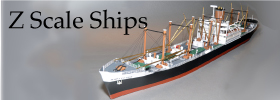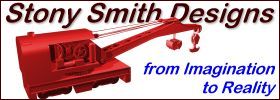- Posts: 12
- Thank you received: 0
Wiring signals
- newtoscale
- Offline
- New Member
-

Less
More
15 years 7 months ago #4074
by newtoscale
Wiring signals was created by newtoscale
Even though I'm a long way from this point, I thought of this last night while I was looking at some pics of layouts with working signals.
I'm refering to those you find along the tracks that indicated if the line ahead is clear or not.
Say I want to install a line signal and control it from my main board, I would run one wire from the signal to the power source, in this case, a terminal block, and the other to the switch right? Now in this case, would I need a third wire to run to the other side of the switch so that when the toggle is up, the light is green and down it's red. Or do I run the wire from the switch to the terminal block and both wire from the signal to the toggle switch?
I'm refering to those you find along the tracks that indicated if the line ahead is clear or not.
Say I want to install a line signal and control it from my main board, I would run one wire from the signal to the power source, in this case, a terminal block, and the other to the switch right? Now in this case, would I need a third wire to run to the other side of the switch so that when the toggle is up, the light is green and down it's red. Or do I run the wire from the switch to the terminal block and both wire from the signal to the toggle switch?
Please Log in or Create an account to join the conversation.
- ausman2001
- Offline
- Senior Member
-

Less
More
- Posts: 278
- Thank you received: 1
15 years 7 months ago #4082
by ausman2001
Replied by ausman2001 on topic Re:Wiring signals
Hi Matt
Are we talking about Marklin or another make of signals? Are they semaphore or light signals?
In case you didn't realise it, with the correct wiring you can stop a train at a red signal, just like with the real thing - at least with Marklin or Viessmann signals anyway (and probably with others too). And when the signal is changed to green the train will proceed, again just like the real thing.
Maybe you need to have a close look at how your railway will operate and draw up a signalling plan, once again like the real thing. That might sound like a lot of fuss, but it could save you a lot of time, trouble and rework later.
Are we talking about Marklin or another make of signals? Are they semaphore or light signals?
In case you didn't realise it, with the correct wiring you can stop a train at a red signal, just like with the real thing - at least with Marklin or Viessmann signals anyway (and probably with others too). And when the signal is changed to green the train will proceed, again just like the real thing.
Maybe you need to have a close look at how your railway will operate and draw up a signalling plan, once again like the real thing. That might sound like a lot of fuss, but it could save you a lot of time, trouble and rework later.
Please Log in or Create an account to join the conversation.
- David K. Smith
- Offline
- Premium Member
-

Less
More
- Posts: 446
- Thank you received: 40
15 years 7 months ago - 15 years 7 months ago #4083
by David K. Smith
Replied by David K. Smith on topic Re:Wiring signals
Ordinarily, working signals are not controlled by the operator via control panel switches. They are controlled by the position and movement of the trains. This requires that the rail line be broken into multiple blocks, each block about the length of the longest train that runs on the line, and a train detection circuit is installed for each block.
The train detection circuit does two things: first, it looks for the presence of a train in its corresponding block; second, it passes this information to the two adjacent blocks. This is done so that the signals can present the three typical aspects: red, for stop (the block ahead is occupied); yellow, for proceed slow (there is a train two blocks ahead), and green for proceed normal (no trains ahead). This is actually the way the "real thing" works.
Most train detection circuits are not scale-specific; most circuits will work in most any scale. Aside from the train detection circuits, you will also need Z scale signals. Presently there is only one pre-made American-style signal available, and it is made by a small shop in Germany, Bernd Bauer. They are available here (scroll to the bottom): www.ztrackcenter.com/electronics/
The train detection circuit does two things: first, it looks for the presence of a train in its corresponding block; second, it passes this information to the two adjacent blocks. This is done so that the signals can present the three typical aspects: red, for stop (the block ahead is occupied); yellow, for proceed slow (there is a train two blocks ahead), and green for proceed normal (no trains ahead). This is actually the way the "real thing" works.
Most train detection circuits are not scale-specific; most circuits will work in most any scale. Aside from the train detection circuits, you will also need Z scale signals. Presently there is only one pre-made American-style signal available, and it is made by a small shop in Germany, Bernd Bauer. They are available here (scroll to the bottom): www.ztrackcenter.com/electronics/
Please Log in or Create an account to join the conversation.
- andyjbj
- Offline
- Junior Member
-

Less
More
- Posts: 148
- Thank you received: 0
15 years 7 months ago #4084
by andyjbj
Replied by andyjbj on topic Re:Wiring signals
I feel that the easiest way is to wire the blocks using one side of of a DPDT, and the other side to switch between red and green on the signal.
Please Log in or Create an account to join the conversation.
- newtoscale
- Offline
- New Member
-

Less
More
- Posts: 12
- Thank you received: 0
15 years 6 months ago #4551
by newtoscale
Replied by newtoscale on topic Re:Wiring signals
I don't know enough about the different manufacturers to give an answer to, but these would be lighted signals and not semaphore.
I am building my layout with block wiring and I have to admit that I don't know enough about the electrics of wiring a layout. The books that I have purchased recently tend to be a bit vague and the diagrams I find, are a trifle confusing.
I would very much like to have my trains control trackside signals but when it comes to stuff like this, I'm a complete moron. If I could find a book or website that provide me with step by step guide on how to control signals with train movement, I'd gladly buy it or go to it. You know. Something like train layout wiring for dummies.
I am building my layout with block wiring and I have to admit that I don't know enough about the electrics of wiring a layout. The books that I have purchased recently tend to be a bit vague and the diagrams I find, are a trifle confusing.
I would very much like to have my trains control trackside signals but when it comes to stuff like this, I'm a complete moron. If I could find a book or website that provide me with step by step guide on how to control signals with train movement, I'd gladly buy it or go to it. You know. Something like train layout wiring for dummies.
Please Log in or Create an account to join the conversation.
- newtoscale
- Offline
- New Member
-

Less
More
- Posts: 12
- Thank you received: 0
15 years 6 months ago #4552
by newtoscale
Replied by newtoscale on topic Re:Wiring signals
I sincerely wish I knew what you were talking about.
Please Log in or Create an account to join the conversation.
- David K. Smith
- Offline
- Premium Member
-

Less
More
- Posts: 446
- Thank you received: 40
15 years 6 months ago - 15 years 6 months ago #4557
by David K. Smith
Replied by David K. Smith on topic Re:Wiring signals
One problem is that there are no standards when it comes to things like train detection--and in order to have the trains control the signals, as they should, then there will be big differences with the wiring depending on the manufacturer of the detectors and/or the signals. Plus, things will change drastically when using DC versus DCC. This is the main reason why you won't find a "beginner's guide" that will show you in step-by-step detail how to install working signals on your layout. If this is what you really want to do, then you'll have to learn model railroad electronics from the ground up. Since you are planning to be at this for 10-12 years, you've got the time. Start with a very basic self-study course in simple, low-voltage DC electronics; this should give you the foundation of understanding for things to come.
Please Log in or Create an account to join the conversation.
- HoboTim
- Offline
- Junior Member
-

Less
More
- Posts: 176
- Thank you received: 12
15 years 6 months ago - 15 years 6 months ago #4563
by HoboTim
Replied by HoboTim on topic Re:Wiring signals
Armand Marx designed a signal system little more than a year ago. He posted the schematics and test video here on the old ZCS. Probably still in the archives.
Anyways, I will be using his system to allow my trains to control the block signals. Will use magnetically controlled Hall-Effect sensors at each block boundary to control the electronics switching the signals. It can be used with DC and DCC without any changes!!
Each block will require a sensor spaced 18" apart(farther or shorter depending on length of consists that will be commonly run). The front loco has a small Neodyne magnet under the front pilot of the lead loco and one under the last car at the coupler.
All magnets have a pull side and a push side. The front loco has the magnet pull side down activating each sensor under the track as it moves forward while the rear magnet has the push side down deactivating each sensorS. The sensors are connected in parallel so it only takes one to activate the signal circuit.
Scenario; Block signal shows red where the consist is traveling. The next block forward shows green. One block behind the loco shows yellow. All other blocks are off. As soon as the magnet in the front loco reaches the block boundary, it crosses over two sensorS side-by-side. One of the sensors is the last sensor of the block just traveled thru and the other is the first for the new block. That means the new block signal changes from green to red. The block in front of it shows green. As soon as the magnet in the last car rolls across the block boundary it deactivates the sensor from the previous block which changes the block that was showing yellow to OFF and the last block from red to yellow.
It consists of alot of wiring, but I think well worth it in the end. Also pretty darn cheap to build and use-able with both DC and DCC.
Hobo Tim
Anyways, I will be using his system to allow my trains to control the block signals. Will use magnetically controlled Hall-Effect sensors at each block boundary to control the electronics switching the signals. It can be used with DC and DCC without any changes!!
Each block will require a sensor spaced 18" apart(farther or shorter depending on length of consists that will be commonly run). The front loco has a small Neodyne magnet under the front pilot of the lead loco and one under the last car at the coupler.
All magnets have a pull side and a push side. The front loco has the magnet pull side down activating each sensor under the track as it moves forward while the rear magnet has the push side down deactivating each sensorS. The sensors are connected in parallel so it only takes one to activate the signal circuit.
Scenario; Block signal shows red where the consist is traveling. The next block forward shows green. One block behind the loco shows yellow. All other blocks are off. As soon as the magnet in the front loco reaches the block boundary, it crosses over two sensorS side-by-side. One of the sensors is the last sensor of the block just traveled thru and the other is the first for the new block. That means the new block signal changes from green to red. The block in front of it shows green. As soon as the magnet in the last car rolls across the block boundary it deactivates the sensor from the previous block which changes the block that was showing yellow to OFF and the last block from red to yellow.
It consists of alot of wiring, but I think well worth it in the end. Also pretty darn cheap to build and use-able with both DC and DCC.
Hobo Tim
Please Log in or Create an account to join the conversation.
- ULie
- Offline
- Banned
-

Less
More
- Posts: 333
- Thank you received: 0
15 years 6 months ago #4567
by ULie
GreetingZ, HilZen,
Uwe
Replied by ULie on topic Re:Wiring signals
Armand goes under the nick "Cleantex", and his old archiv is shown here .Armand Marx designed a signal system little more than a year ago. He posted the schematics and test video here on the old ZCS. Probably still in the archives.
GreetingZ, HilZen,
Uwe
Please Log in or Create an account to join the conversation.
Time to create page: 0.213 seconds
















